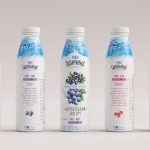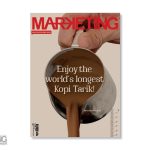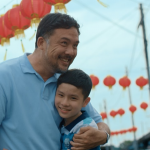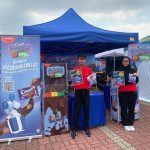Interview by Mark Tungate
What does it take to forge a career as a professional illustrator? We ask Marie-Laure Cruschi, founder of the Paris studio Cruschiform.

How did you start your career? I read that you studied at the Arts Deco (Ecole Nationale Supérieure des Arts Décoratifs) in Paris, but have you wanted to be an illustrator since you were a child?
From my 11th year at school (10th grade) I went to an Applied Art school in Nîmes, in the south of France. Those were the formative years. I’ve retained a curiosity for design and architecture, the pleasure of playing around with technical specifications. Then at the Estienne school (for art and graphic design, in Paris) I discovered a love of illustrated objects, books and the printed image. I learned the fundamentals of my job there. And finally at the Arts Deco, without realizing it, I learned to analyse what prompts me to create, giving my projects a more artistic tone.
After art school you worked for a communications agency. What were your first impressions when you started working in a commercial environment? Was it hard?
After graduating I was lucky enough to be hired as an art director for an agency specializing in luxury. They were looking for a very creative profile, with a fresh eye and a multidisciplinary approach. It was a great opportunity for me to reconnect with the applied arts, to fuel my curiosity well beyond illustration, while developing interdisciplinary skills for approaching and implementing projects. I was looking for this type of experience! I discovered the reality of the market, working to order, pitches, client relations, projects that seemed crazy or far removed from my values, work overload, ideas recycled to infinity, lack of time…All of which quickly made me realize that I had a very independent profile. After a while I felt stifled by the lack of a regenerative project and creative freedom. I needed to reconnect with my true values and aspirations, to develop my personal creative approach. I stepped back and started to reconnect with my home ground.
So you founded your own studio, Cruschiform, in 2007. Can you tell us about what else you do there. Is it focused on illustration, or multi-disciplinary?
After the agency experience I started my art direction studio Cruschiform (https://www.cruschiform.com) in Paris, with the aim of encouraging collaborations. This allowed me to refocus on artistic projects closer to my worlds, in which I could explore my appreciation of photography, typography, graphic design and illustration in a way that’s always on the borderline of art. Over time I developed a stronger know-how in illustration, moving from a very cerebral approach to a more sensitive and narrative one… and eventually illustration took centre stage. So I started doing illustrations for the press, while at the same time developing picture book projects for young people. Today I regularly partner with various communication agencies in France and abroad, who come to me for my artistic universe.
You’ve worked for a very wide range of clients, from Wired to Hermès to Orange. How did you find them? Do you have an agent?
My career really started to take off in 2013. At the time I’d done several illustrations for French magazines, which I’d approached spontaneously. It was a great springboard, because the cultural press is a very stimulating medium for illustrators. It’s an opportunity to explore narrative forms while learning, conveying meaning and sensitivity away from overly narrow briefs. Sometimes you almost get a carte blanche. The speed and regularity of the publications, as well as their wide distribution, quickly gave me a large audience. Then I signed with the agents Talkie Walkie in France and Pekka for English speaking countries, which today bring me a lot more work than I can take on. I’m happy to be able to split my work between three areas with very distinct timelines and economic realities: children’s publishing, the cultural press and advertising complement and balance one another, allowing me to maintain the multi-disciplinary approach that’s important to me.
Can you tell us about your creative process? Where do you look for inspiration before embarking on a project? And what are your favourite creative tools?
I’d say that my sensitivity to colour and geometry have shaped the aesthetics of my work for many years. Even before drawing, colour is my engine, my emotional and narrative support. I like to experiment with harmonies, very often inspired by reality, architecture or nature, which are capable of surprising and refreshing me. Geometry serves as a base for creating strong and expressive compositions. All my illustrations, even the detailed or narrative, start from these two points. Today I work exclusively in digital, on a Cintiq graphic tablet. It enables me to rediscover the pleasure of drawing, the sensuality of curves, the pleasure of modelling and highlighting.
How does this process change when you work with agencies or with a brand?
I think I naturally have a very methodical approach to work. Whether a project is personal or commissioned, the method doesn’t vary that much. I like to start from documentation that I put together on a mood board. It’s a method inherited from my experience at the agency and which allows me to develop an aesthetic universe, a colour scheme, the principles of composition. I like to venture into new territories, so this is an essential step for me. Then I move on to creating, in three steps. A black and white sketch allows me to format the composition, choose the point of view, evoke details. Then the coloured rough allows me to set contrasts, reinforce the structural lines and the rhythm of the image. Very instructive, this step invites you to feel the harmonies and tensions of the image. Lastly, I deepen the illustration and finalize it by refining the details and modelling.
What advice would you give to young illustrators starting their careers?
At the start of your career it’s often the work that comes your way that defines your portfolio. In order not to get stifled in a territory that only half suits you, never forget to renew yourself by taking on commissions and personal projects that will give you the time to find yourself, to ask yourself what makes your work unique. Be confident and persistent.
MARKETING Magazine is not responsible for the content of external sites.
An afternoon of conversations we never had, with leaders most of you never met.
Discover what’s possible from those who made it possible. Plus a preview of The HAM Agency Rankings REPORT 2024.
Limited seats: [email protected]
BOOK SEATS NOW

















